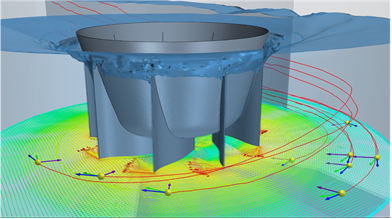Numerical replacement methods
The methodology uses 2 approaches.
(1) A probabilistic approach implemented within the CASIMIR-model framework and based on behavioral rules derived from the results of ethohydraulic experiments. By combining these rules with modeled hydraulic parameters, the areas where fish specifically respond to extreme flow conditions (areas of very high velocities or strong spatial velocity gradients) can be predicted. This can be related to the risk of injury to fish during downstream passage. The advantage of the model is its relatively simple and cost-effective approach, which makes it attractive to users in the field of hydropower planning and licensing and experts with biological and hydraulic engineering backgrounds.

(2) The second approach is based on computational fluid dynamics combined with discrete element method (CFD/DEM). In this approach, a user-defined body force is defined, simulating the swimming capability of the virtual fish. This additional force allows us to manage the speed and direction of the virtual fish (considered as a mass-carrying particle) as it navigates through the specified domain. Its direction is determined by predefined reaction rules and swimming patterns. These reaction rules can be connected using weighting functions, a priority system, or a mix of both, culminating in the final movement or, more specifically, the swimming path of the virtual fish. The fish surrogate interacts with the flow, continuously detecting potential impacts with walls or blades as it moves through the hydraulic machine. From this collision data, we can identify high-risk areas where impacts occur and determine the severity of such collisions. By introducing a statistically significant number of virtual fishes, we can predict the likelihood of strikes in relevant hydraulic setups.
